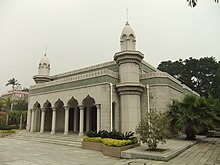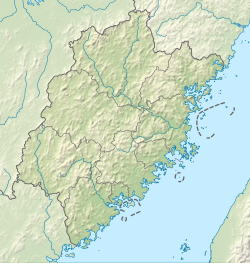| Qingjing Mosque | |
|---|---|
| 清净寺 | |
 | |
| Religion | |
| Affiliation | Islam |
| Branch/tradition | Sunni |
| Location | |
| Location | Quanzhou, Fujian, China |
 | |
| Geographic coordinates | 24°54′09.8″N 118°35′27.4″E / 24.902722°N 118.590944°E / 24.902722; 118.590944 |
| Architecture | |
| Type | mosque |
| Style | Arabic |
| Completed | 1009 |
| Capacity | 300 worshipers |
| UNESCO World Heritage Site | |
| Location | China |
| Part of | Quanzhou: Emporium of the World in Song-Yuan China |
| Criteria | Cultural: (iv) |
| Reference | 1561 |
| Inscription | 2021 (44th Session) |
| Qingjing Mosque | |||||||||||
|---|---|---|---|---|---|---|---|---|---|---|---|
| Traditional Chinese | 清淨寺 | ||||||||||
| Simplified Chinese | 清净寺 | ||||||||||
| Literal meaning | Tranquil Mosque | ||||||||||
| |||||||||||
The Qingjing Mosque (Chinese: 清净寺; Arabic: مسجد الأصحاب, romanized: Masjid al-Aṣḥāb), also known as the Ashab Mosque, is a mosque located in the city of Quanzhou, Fujian, China. It is found on Tumen Street. In 2021, the mosque was inscribed on the UNESCO World Heritage List along with other sites in and around Quanzhou because of its religious significance in the Song and Yuan dynasties, its importance to the medieval maritime trade of China, and its testimony to the global exchange of ideas and cultures during that time.
History
Constructed in 1009, the Arab style mosque is the oldest of its kind in China.
Architecture

Its area is 2,500 square metres. Many Song dynasty mosques were built in this Arabian style in coastal cities, due to communities of Arab merchants living in them. the entrance of Quanzhou Qingjingsi Mosque (Chinese: 泉州清净寺; pinyin: Quán Zhōu Qīng Jìng Sì) is the only example of stone entrances in mainland China. The inscriptions of the Quanzhou Qingjingsi mosque was dominated by the Arabic language.
See also
References
- Kees Versteegh; Mushira Eid (2005). Encyclopedia of Arabic Language and Linguistics: A-Ed. Brill. pp. 379–. ISBN 978-90-04-14473-6.
- "Quanzhou: Emporium of the World in Song-Yuan China". UNESCO World Heritage Centre. United Nations Educational, Scientific, and Cultural Organization. Retrieved 22 Aug 2021.
- Muslims and mosques in Fujian
- Piper Rae Gaubatz (1996). Beyond the Great Wall: urban form and transformation on the Chinese frontiers. Stanford University Press. p. 210. ISBN 0-8047-2399-0. Retrieved 2010-06-28.
- ^ Hagras, Hamada (2019). "Xi'an Daxuexi Alley Mosque: Historical and Architectural Study" (PDF). Egyptian Journal of Archaeological and Restoration Studies. 9 (1): 97–113. doi:10.21608/EJARS.2019.38462.
Further reading
- Steinhardt, Nancy Shatzman (September 2008). "China's Earliest Mosques". Journal of the Society of Architectural Historians. 67 (3): 339–341. doi:10.1525/jsah.2008.67.3.330.
External links
This article about a mosque or other Islamic place of worship in China is a stub. You can help Misplaced Pages by expanding it. |